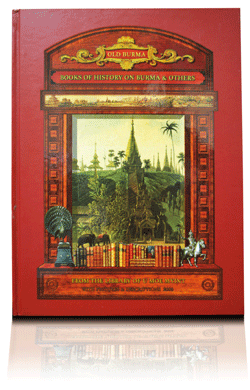Ex Libris
Behind the doors of a Rangoon collector’s amazing library
The catalogue alone is a work of art, its pages edged with gold and packed with rare photographs, pictures and maps covering the history of Burma and Southeast Asia from the 16th century onward.
 |
How, for instance, did first editions of such works as Hemingway’s “The Old Man and the Sea” and T E Lawrence’s “Seven Pillars of Wisdom” come to find room on shelves crowded with volumes devoted to Burma’s early history?
And what is thriller-writer Frederick Forsyth doing here with first editions of his “The Day of the Jackal,” “The Dogs of War” and “The Shepherd”?
One charming illustration in the catalogue gives a clue. It’s a full-page reproduction of the German artist Spitzweg’s painting, “The Bibliophile,” depicting an elderly gentleman in frock coat and breeches, perched at the top of his library steps, balancing books in each hand, under his arms and between his knees.
Moe Myint is a Burmese version of Spitzweg’s bibliophile, a compulsive collector of rare books—and his obsession has taken him far beyond the borders of his native country in search of additions to his eclectic library.
“Collecting books is as old as history itself,” writes Moe Myint in his catalogue. “Without the great book collectors of the past, our libraries would lack many of their greatest treasures.”
The Rangoon businessman has certainly made a great contribution to the documentation of Burma’s early history by building up such an astonishing library. More than 300 of the books are historic or contemporary accounts of Burmese life and culture, most of them dating back to the 19th century and richly illustrated with color plates, photographs and maps.

They include the first full account of Burmese history, by an English emissary, Michael Symes, sent by the Governor General of India to negotiate with the King of Ava at the end of the 18th century. Symes’ account of his seven months in Burma take up four volumes published for the first time in Paris in 1800. All four volumes were acquired by
Moe Myint, together with an English version published the same year in London.
Burmese authors are also well represented in Moe Myint’s library and they include some very famous names. Burma’s first post-independence prime minister, U Nu, wrote a memoir “Burma Under the Japanese,” and a first edition of the work is a centerpiece of this section of Moe Myint’s collection. He describes the book as “a fascinating primary resource.”
A collection of speeches by Burma’s former UN Secretary-General, U Thant, is also here as a first edition. Former Burmese Prime Minister Maung Maung is represented by eight of his works, including an account of the assassination of independence hero Aung San.
Eleven books by Maung Htin Aung, former vice-chancellor of the University of Rangoon and a retired ambassador, cover the full range of his rich writing, from folk stories to political analyses. All are first editions.
Some colonial-era non-Burmese writers assumed Burmese pseudonyms, and the most famous of their works, Shway Yoe’s “The Burman, his Life and Notions,” is among the curiosities of Moe Myint’s library.
The nom de plume Shway Yoe hid the true identity of a Victorian-era Scottish journalist and colonial administrator, James George Scott.
Moe Myint’s catalogue records that Scott’s book “caused a sensation when it was first published because it was considered impossible that a Burman could write so well in English.”
Scott also fooled British readers because of his book’s “unbiased tone and positive curiosity,” Moe Myint writes.
The value of Moe Myint’s library must amount to a staggering sum—a random search of Internet sites listing auction prices indicates that some of his first editions are worth hundreds of dollars.
One gets the impression, however, that such material considerations played no role in Moe Myint’s lifetime task of building his library.
1 | 2 next page »
|
||
|
||
|
||
|
||
